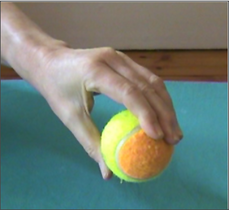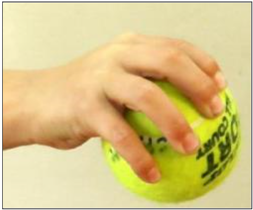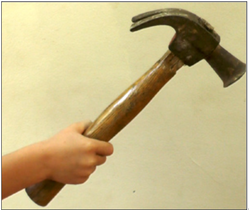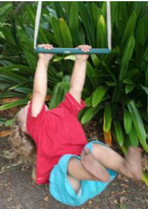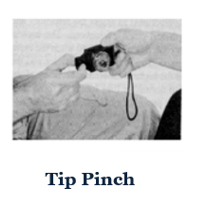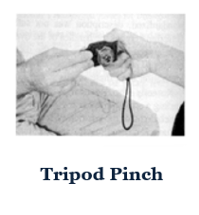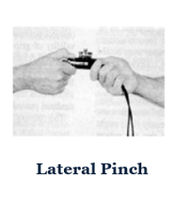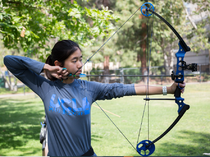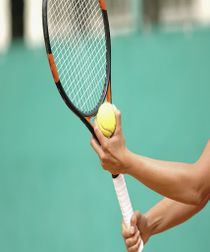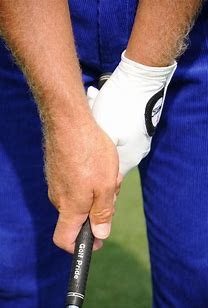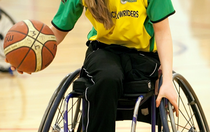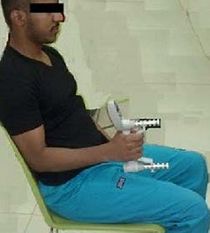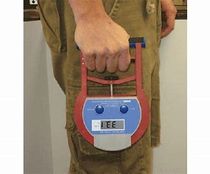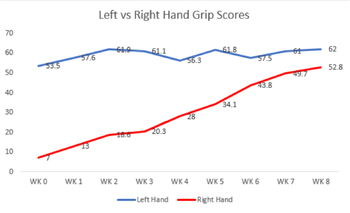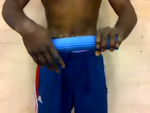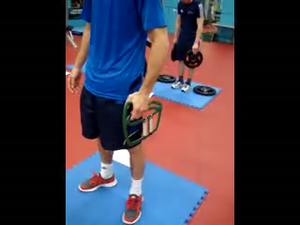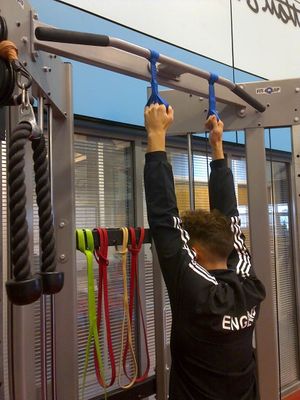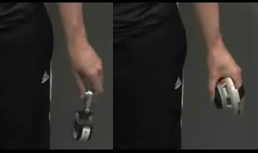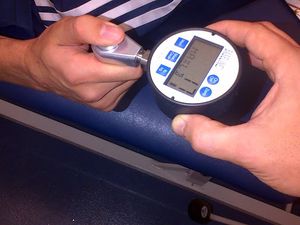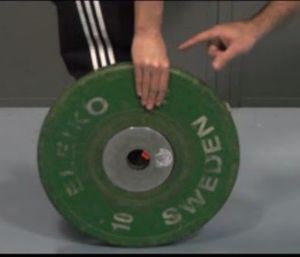Sporting Hand and Wrist - Why Power and Pinch Grips Matter: Difference between revisions
No edit summary |
No edit summary |
||
| Line 6: | Line 6: | ||
== Types of Grip == | == Types of Grip == | ||
The hand anatomy is efficiently organized to carry out a variety of complex tasks combining intricate movements and finely controlled force production. The soft tissue structure is complicated and any injury to any of these even very small structures can alter the overall function of the hand and thereby complicate the therapeutic management<ref>Duruoz MT. Hand function. Springer-Verlag New York; 2016.</ref>. | |||
The ability to fold the fingers into the palms supported by the thenar and hypothenar eminences to make a club-like structure is exclusive to humans<ref name=":2" />. | The ability to fold the fingers into the palms supported by the thenar and hypothenar eminences to make a club-like structure is exclusive to humans<ref name=":2" />. | ||
The hand-wrist represents the most sophisticated tool in the human being. Hand function and strength are important elements in day to day life and participation in sports <ref name=":0">Gatt I, Smith-Moore S, Steggles C, Loosemore M. The takei handheld dynamometer: an effective clinical outcome measure tool for hand and wrist function in boxing. HAND. 2018 May;13(3):319-24.</ref>. | The hand-wrist represents the most sophisticated tool in the human being. [https://physio-pedia.com/Hand_Function#sts=Functional%20Position%20of%20Hand?utm_source=physiopedia&utm_medium=search&utm_campaign=ongoing_internal Hand function] and strength are important elements in day to day life and participation in sports <ref name=":0">Gatt I, Smith-Moore S, Steggles C, Loosemore M. The takei handheld dynamometer: an effective clinical outcome measure tool for hand and wrist function in boxing. HAND. 2018 May;13(3):319-24.</ref>. | ||
1-'''''Power Grip:''''' closing a hand with the thumb in opposition to all other fingers together generates a power grip<ref name=":1">Gatt I. Sporting Hand & Wrist - Why Power & Pinch Grips Matter. Physioplus Course 2020</ref>. | 1-'''''Power Grip:''''' closing a hand with the thumb in opposition to all other fingers together generates a power grip<ref name=":1">Gatt I. Sporting Hand & Wrist - Why Power & Pinch Grips Matter. Physioplus Course 2020</ref>. | ||
| Line 92: | Line 94: | ||
A study by Loosemore et al<ref name=":2">Loosemore M, Lightfoot J, Gatt I, Hayton M, Beardsley C. Hand and wrist injuries in elite boxing: a longitudinal prospective study (2005-2012) of the Great Britain Olympic Boxing Squad. Hand. 2017 Mar;12(2):181-7.</ref> explored hand and wrist injuries in both training and competitions in boxing found: | A study by Loosemore et al<ref name=":2">Loosemore M, Lightfoot J, Gatt I, Hayton M, Beardsley C. Hand and wrist injuries in elite boxing: a longitudinal prospective study (2005-2012) of the Great Britain Olympic Boxing Squad. Hand. 2017 Mar;12(2):181-7.</ref> explored hand and wrist injuries in both training and competitions in boxing found: | ||
* Boxer's Knuckles (Finger carpometacarpal instability and finger metacarpophalangeal joint extensor hood and capsule sprain) to be the most common injury. | * [https://physio-pedia.com/Traumatic_Extensor_Hood_Rupture?utm_source=physiopedia&utm_medium=search&utm_campaign=ongoing_internal Boxer's Knuckles] (Finger carpometacarpal instability and finger metacarpophalangeal joint extensor hood and capsule sprain) to be the most common injury. | ||
* The incidence of training injuries was similar to that of competition injuries. | * The incidence of training injuries was similar to that of competition injuries. | ||
The study also measured the grip strength in both hands at baseline and after injuries and concluded: | The study also measured the grip strength in both hands at baseline and after injuries and concluded: | ||
Revision as of 19:35, 28 December 2020
Types of Grip[edit | edit source]
The hand anatomy is efficiently organized to carry out a variety of complex tasks combining intricate movements and finely controlled force production. The soft tissue structure is complicated and any injury to any of these even very small structures can alter the overall function of the hand and thereby complicate the therapeutic management[1].
The ability to fold the fingers into the palms supported by the thenar and hypothenar eminences to make a club-like structure is exclusive to humans[2].
The hand-wrist represents the most sophisticated tool in the human being. Hand function and strength are important elements in day to day life and participation in sports [3].
1-Power Grip: closing a hand with the thumb in opposition to all other fingers together generates a power grip[4].
A-Lumbrical grip
B-Spherical grip
C-Hammer grip
D-Hook grip
| Lumbrical grip | Spherical grip | Hammer grip | Hook grip |
|---|
2-Pinch grip: generated by pressing the thumb pulp against the pulp of the index, middle, ring, and little fingers’ distal phalanges[3].
A-Tip Pinch: index pressing against the thumb
B-Tripod Pinch: adding the middle finger
C-Lateral Pinch, also known as key pinch: achieved by pressing the thumb pulp against the lateral aspect of the proximal interphalangeal joint of the index finger. In this grip, the thumb is going into adduction and flexion[4]
| Tip Pinch | Tripod Pinch | Lateral Pinch |
|---|
Grip in Sports[edit | edit source]
Different sports require different grips, often differs between hands. If you are involved in sports rehabilitation, understanding the type of grip and involvement of the thumb is important to measure the strength and address any related injuries.
Here are some examples of different grips used in various sports[4]:
Bow and arrow: the lead hand holding the bow and keeping it stable will use a power grip. Whereas the backhand, pulling the string, also in power grip but the thumb is less involved going into more adduction.
Raquet sports such as tennis: hand holding the racket using a power grip and the other hand holding the ball in a pinch grip. By changing the grip, the movement and the force change.
Golf: Lateral pinch or key grip is used but that could change during the game depending on the movement and how much strength is required.
Wheelchair sports, for example, basketball: the hand holding the wheelchair would require more strength from the thumb for stability. the other hand holding the ball would use a spherical grip in which there will be cupping at the wrist and adduction at the thumb.
Weight lifting: the use of a hook grip is recommended in weightlifting movements[5]
Boxing: Power grip is used. Injury at the base of the CMC joints of the index and middle fingers is common causing instability and interferes with the gripping power[4].
Measuring Grip Strength[edit | edit source]
Considerations:[edit | edit source]
Dynamometer[3]: the Jamar and the Takei are the most common studied dynamometers in the literature.
The Jamar dynamometer is considered to be the gold standard for documenting manual grip strength. It is comprised of:
- an adjustable anatomical rigid handle
- hydraulic system
- analog display
The Takei is a valid and reliable tool to measure power grip. It is comprised of:
- Adjustable rectified
- Complacent handle shape
- Electromechanical system
- A digital or analog display
When testing strength, it's good to note the associated symptoms and the difference between the right and left hands
Testing for 3 times. A tip: start with the non-painful side then move on the other hand and alternate the testing between hands for three times
Looking for the peak force referring to the best number. Some people might be able to generate a high number on the strength test but then the number lowers due to fatigue or they take few repetitions to generate the force
Testing position:
1- elbow in a 90-degree angle: helps to generate the highest peak. However, having the forearm in mid-position could lead to contraction of the brachioradialis muscle and the movement will not be generated purely from the hand.
2- testing from straight elbow position and wrist in neutral isolate hand muscles.
Comparing to the other side rather than how strong it. Consider the element of chronicity could lead to weakness due to reciprocal inhibition [4]
A study by Loosemore et al[2] explored hand and wrist injuries in both training and competitions in boxing found:
- Boxer's Knuckles (Finger carpometacarpal instability and finger metacarpophalangeal joint extensor hood and capsule sprain) to be the most common injury.
- The incidence of training injuries was similar to that of competition injuries.
The study also measured the grip strength in both hands at baseline and after injuries and concluded:
A difference of 15% between both hands is considered normal
Boxers who had a difference of 20% are likely to have an injury. Higher than 20% places the athlete at a higher risk for pathologies.
Following an injury, an 87% difference in bilateral hand gripping strength was observed in the same study.
Rehabilitation of Grip[edit | edit source]
Power Grip:
A case study of a boxing injury: Handgrip strength was tripled in three weeks of conservative management[4] and the difference dropped from 87% to 15% on testing between right and left hands
Functional rehabilitation is recommended. Monitoring symptoms and progression into function training and power grip training.
Isokinetic training machine:
Expensive but a useful kinetic machine
Can be used to measure the flexor/extensor muscle strength both eccentrically and concentrically with speed variations. The same measures could be adjusted for rehabilitation.
Other equipment:
rubber tools also known as flex bars. Can be used in different forms to target the wrist and forearm muscles. Also can be used for different purposes, strength and conditioning. The Intensity is linked with the number of repetitions but you can advice different colours for different strengths.
Crushes: is another tool that could be used to improve the power grip. The spring can change the strength.
Talon grips: designed ergonomically to adapt to the shape of the hand to give uniform loading on the tendons, can be used with pull-ups.
The width of the grip used by the athlete is a factor to be considered such as in rugby or Javalin and putters and the amount of time the athlete is gripping.
Pinch Grip:
There are two different types of dynamometers.
Pinch grip dynamometer or handheld dynamometer: there are two positions to hold and exercise from.
key grip: useful to strengthen the flexors and places the joint in a closed position. Involves the thumb more than the pinch grip.
The use of which grip or position depends on the onset and severity of injury.
.
A plate can be used to strengthen the grip: there are different variations depending on which muscles to involve. The time to hold can be adjusted on the type of training and also could be used to check the maximum hold between right and left hands.
Monitoring the symptoms associated withholding such as pain, time of occurrence and effect on holding can be useful data int eh management.
Putty: can help with a pinch grip using different variations
Flipping Plates: good exercise to improve thumb and wrist proprioception.
References[edit | edit source]
- ↑ Duruoz MT. Hand function. Springer-Verlag New York; 2016.
- ↑ 2.0 2.1 Loosemore M, Lightfoot J, Gatt I, Hayton M, Beardsley C. Hand and wrist injuries in elite boxing: a longitudinal prospective study (2005-2012) of the Great Britain Olympic Boxing Squad. Hand. 2017 Mar;12(2):181-7.
- ↑ 3.0 3.1 3.2 Gatt I, Smith-Moore S, Steggles C, Loosemore M. The takei handheld dynamometer: an effective clinical outcome measure tool for hand and wrist function in boxing. HAND. 2018 May;13(3):319-24.
- ↑ 4.0 4.1 4.2 4.3 4.4 4.5 Gatt I. Sporting Hand & Wrist - Why Power & Pinch Grips Matter. Physioplus Course 2020
- ↑ Oranchuk DJ, Drinkwater EJ, Lindsay RS, Helms ER, Harbour ET, Storey AG. Improvement of kinetic, kinematic, and qualitative performance variables of the power clean with the hook grip. International journal of sports physiology and performance. 2019 Mar 1;14(3):378-84.
- ↑ Pinch grip strength putty R. Available from:https://www.youtube.com/watch?v=QxaP5P9CSWc[last accessed 28/12/2020]
- ↑ Power grip strength putty R. Available from:https://www.youtube.com/watch?v=DufAYWGidsc[last accessed 28/12/2020]
- ↑ Plate Flip | Better Grip | Forearm Strength | Move and Perform Better. Available from:https://www.youtube.com/watch?v=Z-qNThP5Sjw[last accessed 28/12/2020]
